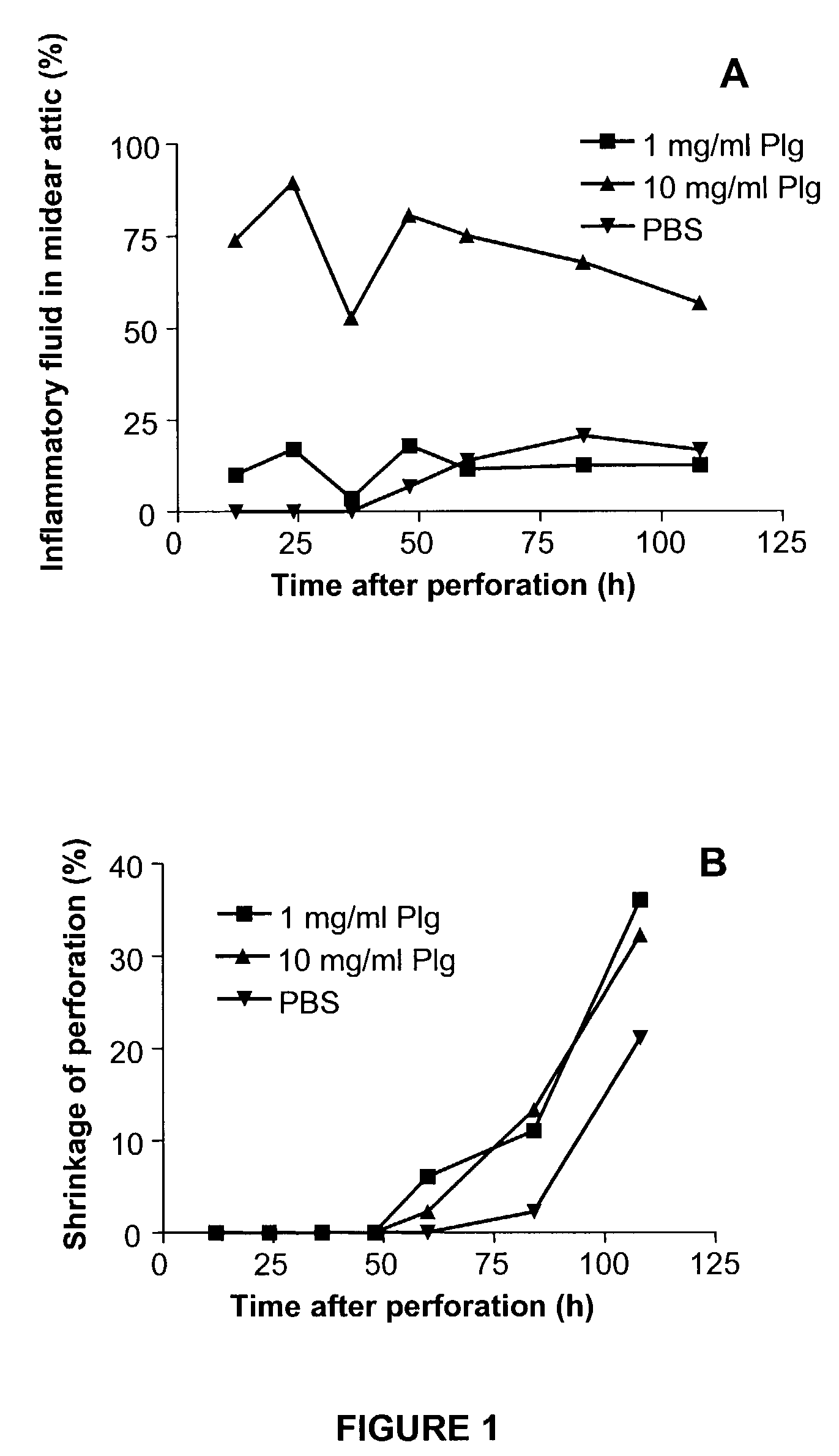Method of promoting healing of a tympanic membrane perforation
a technology of tympanic membrane and perforation, which is applied in the field of wound healing processes, can solve the problems of slow or improper wound healing, affecting the quality of life of large numbers of people, and affecting the quality of life of people, and the precise mechanism responsible for this process, and how they are regulated, so as to improve the healing of tympanic membrane perforations and minimize scar formation
- Summary
- Abstract
- Description
- Claims
- Application Information
AI Technical Summary
Benefits of technology
Problems solved by technology
Method used
Image
Examples
example 1
Healing of Disrupted Tympanic Membranes in Wild-Type and Plasminogen-Deficient Mice
[0087]This Example shows that plasminogen-deficient mice had delayed and abnormal wound healing compared to wild type control siblings. Short term studies between plasminogen deficient and wild type control mice showed from as early as 6 hours after perforation performed, plasminogen deficient mice had much higher inflammatory response indicating plasminogen function as early as the inflammation stage of wound healing.
Methods
[0088]Mice. Adult male plasminogen gene deficient and wildtype sibling mice (C57BL / 6J, 8–12 week old) were genotyped by a chromogenic activity assay, which determines the level of plasminogen in mouse plasma (Ny et al., Endocrinology. 140(11):5030–5 (1999)) and confirmed with PCR. The mice were anesthetized and under an otomicroscope their tympanic membranes were perforated with a myringotomy lancet. The perforation occupied the upper posterior quadrant of the tympanic membrane.
[0...
example 2
Tympanic Membrane Healing in Plasminogen-deficient Mice Reconstituted with Plasminogen
[0098]This Example demonstrates that by reconstitution of plasminogen in plasminogen deficient mice by systemic administration, the phenotype was converted completely back to normal wound healing.
Methods
[0099]This experiment was performed in a similar manner as Example 1, except for administration of plasminogen to one group of animals.
[0100]Reconstitution of plasminogen in plasminogen deficient mice. Human plasminogen was reconstituted in plasminogen-deficient mice by repeated intravenous injections of 1.5 mg plasminogen in 100 μl phosphate-buffered saline (PBS). The first dose was administered 12 hours prior to perforation of the tympanic membrane. Thereafter, plasminogen was administered every 24 hours throughout the duration of the experiment.
Results
[0101]Reconstitution of plasminogen in plasminogen deficient mice by i.v. injection restored the normal wound healing in plasminogen deficient mice...
example 3
Healing of Tympanic Membrane Perforations in tPA-Deficient Mice
[0104]Tympanic membranes (TM) of tPA-deficient (tPA− / −) and wild-type mice were perforated at day 0, and the healing pattern was followed under otomicrocope, as described above. The results are described in Table 4. tPA-deficient mice back-crossed 6 times to C57B1 / 6 background were crossed once to DBA1 / J background. The heterozygous litters were used for breeding. The wild-type (tPA+ / +) and homozygous (tPA− / −) offspring from these breedings were used in the wound-healing experiments.
[0105]
TABLE 4Healing Of Tympanic Membranes In tPA-Deficient Mice.The table shows the fraction of healed tympanic membranes in eachgroup at each time point.Time after perforation (days):46812tPA+ / + mice:0 / 205 / 14 9 / 146 / 6tPA+ / + mice:0 / 244 / 1610 / 168 / 8
[0106]The healing pattern of TM perforation in tPA− / − mice was identical to that of wild type control mice, and the quality of healed TM tissue in tPA− / − mice and wild type controls appeared identical...
PUM
| Property | Measurement | Unit |
|---|---|---|
| Density | aaaaa | aaaaa |
| Fraction | aaaaa | aaaaa |
| Fraction | aaaaa | aaaaa |
Abstract
Description
Claims
Application Information
 Login to View More
Login to View More - R&D
- Intellectual Property
- Life Sciences
- Materials
- Tech Scout
- Unparalleled Data Quality
- Higher Quality Content
- 60% Fewer Hallucinations
Browse by: Latest US Patents, China's latest patents, Technical Efficacy Thesaurus, Application Domain, Technology Topic, Popular Technical Reports.
© 2025 PatSnap. All rights reserved.Legal|Privacy policy|Modern Slavery Act Transparency Statement|Sitemap|About US| Contact US: help@patsnap.com

